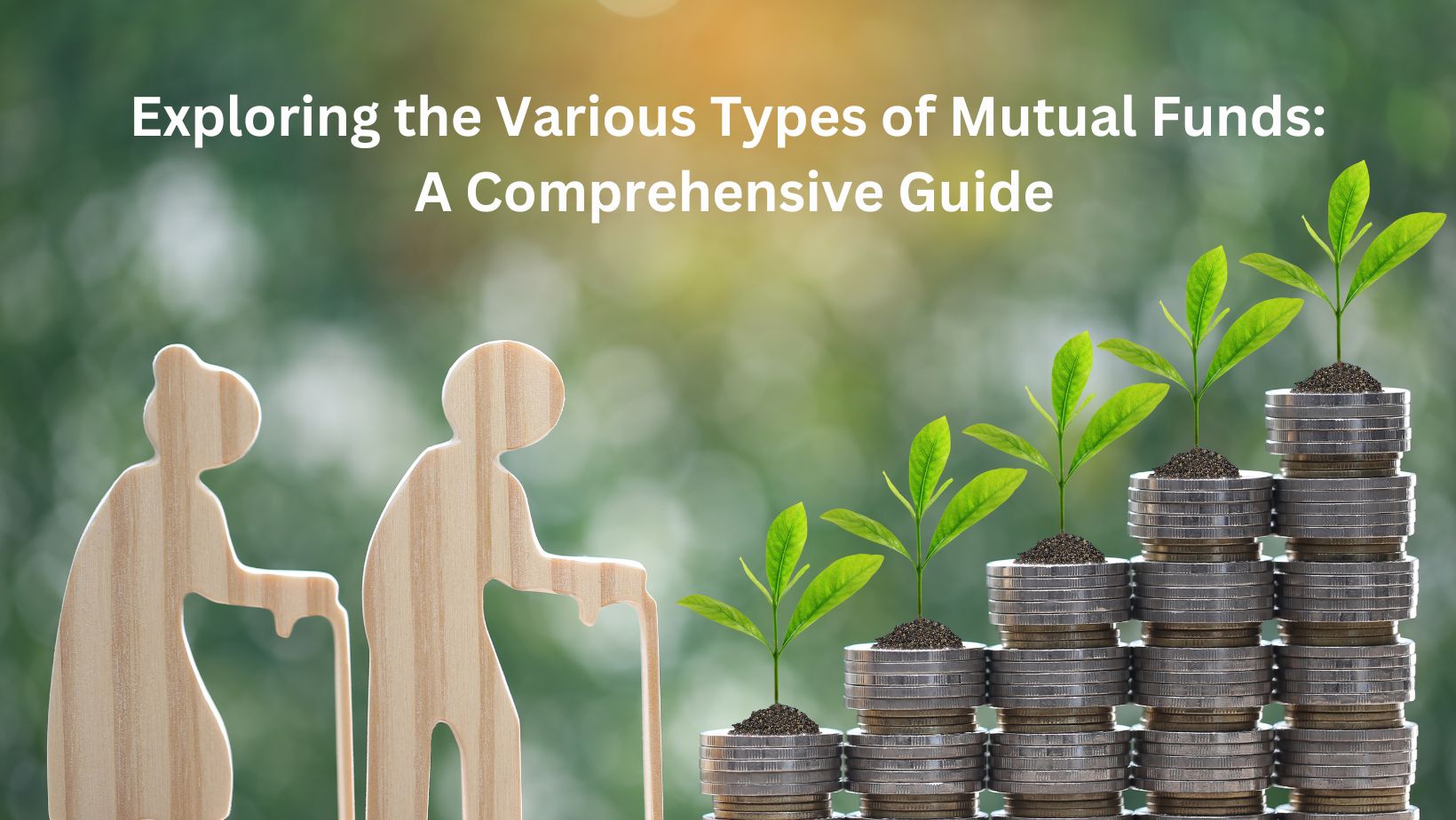Exploring the Various Types of Mutual Funds: A Comprehensive Guide
Mutual funds are a popular investment vehicle that pools money from multiple investors to invest in a diverse range of securities such as stocks, bonds, and other assets. One of the key advantages of mutual funds is their ability to offer diversification and professional management to investors with varying risk appetites and investment goals. In this comprehensive guide, we'll delve into the different types of mutual funds available in the market, each catering to specific investment objectives and preferences.
1. Equity Funds:
Equity funds invest primarily in stocks or equities, offering investors the potential for long-term capital appreciation. These funds may focus on specific market segments such as large-cap, mid-cap, or small-cap stocks, or they may follow a thematic approach by investing in sectors like technology, healthcare, or energy. Equity funds tend to be more volatile compared to other types of mutual funds due to the inherent risks associated with stock market fluctuations.
2. Fixed-Income Funds:
Fixed-income funds, also known as bond funds, invest in a portfolio of bonds issued by governments, corporations, or other entities. These funds aim to provide investors with regular income through interest payments while preserving capital. Fixed-income funds vary in terms of the types of bonds they hold, including government bonds, corporate bonds, municipal bonds, and high-yield bonds. They are generally considered less risky than equity funds but may still be subject to interest rate and credit risk.
3. Balanced Funds:
Balanced funds, also referred to as hybrid funds, invest in a mix of stocks and bonds to achieve a balanced portfolio. These funds aim to provide both capital appreciation and income generation while managing overall portfolio risk. Balanced funds typically maintain a predetermined asset allocation between equities and fixed-income securities, with variations based on the fund manager's investment strategy and market conditions.
4. Money Market Funds:
Money market funds invest in short-term, low-risk securities such as Treasury bills, certificates of deposit (CDs), and commercial paper. These funds aim to preserve capital and provide investors with liquidity and stability. Money market funds are often used as a cash management tool or as a temporary parking place for funds awaiting investment in other asset classes. While they offer lower returns compared to equity or fixed-income funds, they are considered relatively safe investments.
5. Specialty Funds:
Specialty funds focus on specific sectors, themes, or investment strategies that may not be covered by traditional mutual funds. Examples of specialty funds include sector funds (e.g., technology, healthcare), thematic funds (e.g., renewable energy, artificial intelligence), and alternative investment funds (e.g., real estate, commodities). Specialty funds may offer investors the opportunity to capitalize on niche market trends or unique investment opportunities but may also carry higher risk and volatility.
6. Index Funds:
Index funds seek to replicate the performance of a specific market index, such as the S&P 500 or the FTSE 100, by holding a portfolio of securities that closely mirrors the index's composition. These funds aim to provide investors with returns that closely track the overall market while offering lower fees compared to actively managed funds. Index funds are popular among investors seeking broad market exposure and passive investment strategies.
7. Exchange-Traded Funds (ETFs):
While technically not mutual funds, ETFs share many similarities with mutual funds in terms of structure and investment approach. ETFs are traded on stock exchanges like individual stocks and offer investors exposure to a wide range of asset classes, sectors, and investment strategies. Like index funds, ETFs can provide low-cost, diversified investment options and are suitable for both short-term trading and long-term investing.
In conclusion, the world of mutual funds offers a diverse array of investment options tailored to meet the varying needs and preferences of investors. Whether you're seeking growth, income, capital preservation, or a combination of these objectives, there's likely a mutual fund that aligns with your investment goals. By understanding the different types of mutual funds and their characteristics, investors can make informed decisions to build a well-rounded investment portfolio suited to their individual financial circumstances and aspirations.
For more information visit us @ https://freestudyspace.com/types-of-mutual-funds/
People
Circles
Posts
The poisoning of our food supply. Did you know that seed oils, palm oil, canola oil are toxic? They were originally used to lubricate farm machinery and cars because they were not edible. Today, corporations put them in the food supply because they are cheap. https://www.youtube.com/watch?v=VqjV_X6gqY8 #food #foodsupply #poison #seedOils
New "data protection" bill in the U.K. expands ability of banks and corporations to surveil customers
https://newstarget.com/2024-04-11-new-data-bill-uk-expand-surveillance-powers-corporations.html

A bill is currently making its way through the parliament of the United Kingdom, which could grant the country’s government with extraordinary new financial surveillance powers. The Data Protection and Digital Information (DPDI) bill proposes changes to the U.K.’s General Data Protection Regulations, which provide the foundation for the rules and principles that govern how […]
www.newstarget.com
Videos
Remember when everything caused cancer? Well now Climate Change causes everything. People are blaming natural disasters, the war in Ukraine, divorce, and even a rise in domestic abuse on climate change. You know who isn’t getting the blame? The big corporations who dump millions of tons of waste into our oceans and landfills every year, killing fish and sending toxic chemicals into our land and waterways. On this episode of 360 View, Soctti Nell Hughes speaks with Patrick Moore, an Ecologist and Environmentalist, and Founding member of Greenpeace about how the excuse of climate change simply is being used to divert power to authoritarian governments to gain control of how you commute to work, when you heat your home, and, yes, even cook on your stove.
LIVE @ 7pm: Part 2 of #NeverAgainIsNowGlobal boldly exposes the financial interests and the corporations that drove the Holocaust.
Record-breaking #’s of viewers watched LIVE from over 90 countries last night ? Share with everyone you know!
? https://bit.ly/3wFukWB #NeverAgain
Humanity is in a very dangerous position right now. Powerful corporations using military-grade psychological warfare programs are rolling out a bio-medical tyranny worldwide and it’s up to We The People to peacefully resist!
sʜᴏᴘ: https://InfowarsStore.com
ᴅɪʀᴇᴄᴛ ᴄᴏɴᴛʀɪʙᴜᴛɪᴏɴ: https://www.infowarsstore.com/support-infowars
People
Circles
Videos
Remember when everything caused cancer? Well now Climate Change causes everything. People are blaming natural disasters, the war in Ukraine, divorce, and even a rise in domestic abuse on climate change. You know who isn’t getting the blame? The big corporations who dump millions of tons of waste into our oceans and landfills every year, killing fish and sending toxic chemicals into our land and waterways. On this episode of 360 View, Soctti Nell Hughes speaks with Patrick Moore, an Ecologist and Environmentalist, and Founding member of Greenpeace about how the excuse of climate change simply is being used to divert power to authoritarian governments to gain control of how you commute to work, when you heat your home, and, yes, even cook on your stove.
LIVE @ 7pm: Part 2 of #NeverAgainIsNowGlobal boldly exposes the financial interests and the corporations that drove the Holocaust.
Record-breaking #’s of viewers watched LIVE from over 90 countries last night ? Share with everyone you know!
? https://bit.ly/3wFukWB #NeverAgain
Humanity is in a very dangerous position right now. Powerful corporations using military-grade psychological warfare programs are rolling out a bio-medical tyranny worldwide and it’s up to We The People to peacefully resist!
sʜᴏᴘ: https://InfowarsStore.com
ᴅɪʀᴇᴄᴛ ᴄᴏɴᴛʀɪʙᴜᴛɪᴏɴ: https://www.infowarsstore.com/support-infowars
Following The Money Trail: What’s “Plan Vx”? Dr. Peter McCullough reveals more on the glaring conflicts of interest between CDC + large corporations that lead to widespread, coercive vaccine mandates on #CHDTV
⏯ https://bit.ly/3IT1hpV
I go over how the How the IRS has been used as a political targeting tool against Americans.
If you want to learn about my principles and values, pick up: The Definitive Guide to Libertarian Voluntaryism:
https://amzn.to/3DEnMdm
(affiliate)
Catch behind-the-scenes posts and help choose my next video topic at:
Patreon: https://www.patreon.com/thepholosopher
SubscribeStar: https://www.subscribestar.com/the-pholosopher
Sources and transcript: https://ecency.com/politics/@thepholosopher/how-the-irs-has-been
#libertarian #taxationistheft #history #endthefed #americanhistory
Posts
Exploring the Various Types of Mutual Funds: A Comprehensive Guide
Mutual funds are a popular investment vehicle that pools money from multiple investors to invest in a diverse range of securities such as stocks, bonds, and other assets. One of the key advantages of mutual funds is their ability to offer diversification and professional management to investors with varying risk appetites and investment goals. In this comprehensive guide, we'll delve into the different types of mutual funds available in the market, each catering to specific investment objectives and preferences.
1. Equity Funds:
Equity funds invest primarily in stocks or equities, offering investors the potential for long-term capital appreciation. These funds may focus on specific market segments such as large-cap, mid-cap, or small-cap stocks, or they may follow a thematic approach by investing in sectors like technology, healthcare, or energy. Equity funds tend to be more volatile compared to other types of mutual funds due to the inherent risks associated with stock market fluctuations.
2. Fixed-Income Funds:
Fixed-income funds, also known as bond funds, invest in a portfolio of bonds issued by governments, corporations, or other entities. These funds aim to provide investors with regular income through interest payments while preserving capital. Fixed-income funds vary in terms of the types of bonds they hold, including government bonds, corporate bonds, municipal bonds, and high-yield bonds. They are generally considered less risky than equity funds but may still be subject to interest rate and credit risk.
3. Balanced Funds:
Balanced funds, also referred to as hybrid funds, invest in a mix of stocks and bonds to achieve a balanced portfolio. These funds aim to provide both capital appreciation and income generation while managing overall portfolio risk. Balanced funds typically maintain a predetermined asset allocation between equities and fixed-income securities, with variations based on the fund manager's investment strategy and market conditions.
4. Money Market Funds:
Money market funds invest in short-term, low-risk securities such as Treasury bills, certificates of deposit (CDs), and commercial paper. These funds aim to preserve capital and provide investors with liquidity and stability. Money market funds are often used as a cash management tool or as a temporary parking place for funds awaiting investment in other asset classes. While they offer lower returns compared to equity or fixed-income funds, they are considered relatively safe investments.
5. Specialty Funds:
Specialty funds focus on specific sectors, themes, or investment strategies that may not be covered by traditional mutual funds. Examples of specialty funds include sector funds (e.g., technology, healthcare), thematic funds (e.g., renewable energy, artificial intelligence), and alternative investment funds (e.g., real estate, commodities). Specialty funds may offer investors the opportunity to capitalize on niche market trends or unique investment opportunities but may also carry higher risk and volatility.
6. Index Funds:
Index funds seek to replicate the performance of a specific market index, such as the S&P 500 or the FTSE 100, by holding a portfolio of securities that closely mirrors the index's composition. These funds aim to provide investors with returns that closely track the overall market while offering lower fees compared to actively managed funds. Index funds are popular among investors seeking broad market exposure and passive investment strategies.
7. Exchange-Traded Funds (ETFs):
While technically not mutual funds, ETFs share many similarities with mutual funds in terms of structure and investment approach. ETFs are traded on stock exchanges like individual stocks and offer investors exposure to a wide range of asset classes, sectors, and investment strategies. Like index funds, ETFs can provide low-cost, diversified investment options and are suitable for both short-term trading and long-term investing.
In conclusion, the world of mutual funds offers a diverse array of investment options tailored to meet the varying needs and preferences of investors. Whether you're seeking growth, income, capital preservation, or a combination of these objectives, there's likely a mutual fund that aligns with your investment goals. By understanding the different types of mutual funds and their characteristics, investors can make informed decisions to build a well-rounded investment portfolio suited to their individual financial circumstances and aspirations.
For more information visit us @ https://freestudyspace.com/types-of-mutual-funds/
The poisoning of our food supply. Did you know that seed oils, palm oil, canola oil are toxic? They were originally used to lubricate farm machinery and cars because they were not edible. Today, corporations put them in the food supply because they are cheap. https://www.youtube.com/watch?v=VqjV_X6gqY8 #food #foodsupply #poison #seedOils
New "data protection" bill in the U.K. expands ability of banks and corporations to surveil customers
https://newstarget.com/2024-04-11-new-data-bill-uk-expand-surveillance-powers-corporations.html

A bill is currently making its way through the parliament of the United Kingdom, which could grant the country’s government with extraordinary new financial surveillance powers. The Data Protection and Digital Information (DPDI) bill proposes changes to the U.K.’s General Data Protection Regulations, which provide the foundation for the rules and principles that govern how […]
www.newstarget.com
New "data protection" bill in the U.K. expands ability of banks and corporations to surveil customers
https://www.naturalnews.com/2024-04-11-new-data-bill-uk-expand-surveillance-powers-corporations.html

A bill is currently making its way through the parliament of the United Kingdom, which could grant the country’s government with extraordinary new financial surveillance powers. The Data Protection and Digital Information (DPDI) bill proposes changes to the U.K.’s General Data Protection Regulations, which provide the foundation for the rules and principles that govern how […]
www.naturalnews.com
Global Trends Meet Corporate Accountability: My Insights on ESRS Cross-Cutting Requirements
Introduction:
In an era where global sustainability trends are increasingly influencing corporate accountability, the European Sustainability Reporting Standards (ESRS) have emerged as a pivotal framework. The Cross-Cutting Requirements within these standards represent a significant stride towards harmonizing sustainability reporting across borders. As someone navigating the intersection of global trends and corporate responsibility, my journey through these requirements has been enlightening and challenging. This blog post shares my experiences and the broader implications for corporations striving to align with global sustainability trends.
The Global Call for Transparency:
The rollout of the ESRS Cross-Cutting Requirements resonated with the global call for enhanced transparency and accountability in corporate sustainability practices. It presented an opportunity for our organization to not only align with European standards but also to set a benchmark in global corporate sustainability reporting.
Navigating the ESRS Landscape:
Understanding the Global Context: The first step in our journey was to contextualize the ESRS Cross-Cutting Requirements within the broader global sustainability trends. This understanding was crucial for developing a reporting strategy that was not only compliant but also reflective of global sustainability goals.
Forming a Global Task Force: To tackle the complexities of the ESRS, I assembled a task force with global representation. This team's diverse international perspective was instrumental in ensuring our approach to the ESRS was globally informed and locally applicable.
Data Collection with a Global Lens: One of the core challenges under the ESRS is the collection of sustainability data that is both comprehensive and globally relevant. We adopted innovative data collection methodologies that allowed us to capture sustainability data reflective of our global operations.
Engaging Global Stakeholders: A key strategy in our approach was the engagement of stakeholders across our global footprint. This engagement ensured that our sustainability reports were not only ESRS-compliant but also resonant with our global stakeholders' expectations and the broader sustainability trends.
Leveraging Global Educational Initiatives: Recognizing the importance of global awareness and understanding of the ESRS standards, we launched educational initiatives across our organization. These programs were designed to empower our global team, fostering a culture of sustainability that transcends borders.
Integrating Global Trends into Reporting: The Cross-Cutting Requirements encouraged us to integrate global sustainability trends into our corporate reporting. This integration ensured that our reports were not only aligned with the ESRS but also with the evolving global sustainability landscape.
Crafting a Globally Resonant Narrative: Reporting under the ESRS framework became an opportunity to articulate our commitment to global sustainability. We focused on creating a narrative that was transparent, engaging, and reflective of our global sustainability efforts and achievements.
Seeking External Assurance for Global Credibility: To enhance the credibility of our reports on a global scale, we pursued external assurance. This step was crucial in demonstrating our commitment to the ESRS standards and our alignment with global sustainability trends.
Implications for Global Corporate Sustainability:
Navigating the ESRS Cross-Cutting Requirements has underscored the importance of aligning corporate sustainability reporting with global trends and standards. It has highlighted the role of corporations in driving global sustainability efforts through transparent and accountable reporting.
For Corporations at the Crossroads of Global Trends:
For corporations seeking to navigate the intersection of global sustainability trends and corporate accountability, the ESRS Cross-Cutting Requirements offer a unique opportunity to lead in sustainability reporting. Embrace these standards as a means to enhance your global sustainability practices and reporting, setting a benchmark in corporate accountability.
For a comprehensive guide to navigating these requirements and aligning with global sustainability trends, I highly recommend visiting: https://socious.io/blog/esrs-cross-cutting-requirements. This resource has been instrumental in guiding our approach, providing clarity and actionable insights for embracing the ESRS within the global sustainability framework.
Conclusion:
My journey through the ESRS Cross-Cutting Requirements has been a testament to the evolving relationship between global sustainability trends and corporate accountability. As we continue to adapt and evolve our reporting practices, let us do so with a commitment to global sustainability, transparency, and the pursuit of a more accountable corporate world.


















